Lagging productivity in construction is driving up building costs
Construction labour productivity has fallen over the past 25 years, which has made the construction sector relatively more expensive than manufacturing. Labour shortages remain high as a result
More than 40% of EU construction firms said they would raise their prices in November 2022, according to a European Commission survey. Higher material prices are mostly to blame for this. Other business sectors are also grappling with higher purchase prices. Yet, construction firms now report charging higher prices more often than the manufacturing sector. This is also reflected in their production prices. In recent years, these price increases in EU construction have averaged above those in manufacturing. From 2012 to 2020, the average price increase of production (value-added share) in European construction was 2.3% per year compared to 1.0% in manufacturing. In the preceding period (2002-11), the price difference was even greater. Although these might seem like small differences, EU construction sector prices have almost doubled from 1995 to 2020, while those in manufacturing have increased by less than 20%. This has made construction significantly more expensive than manufacturing.
The construction sector is becoming more expensive
Average price change of the added value per year in the EU
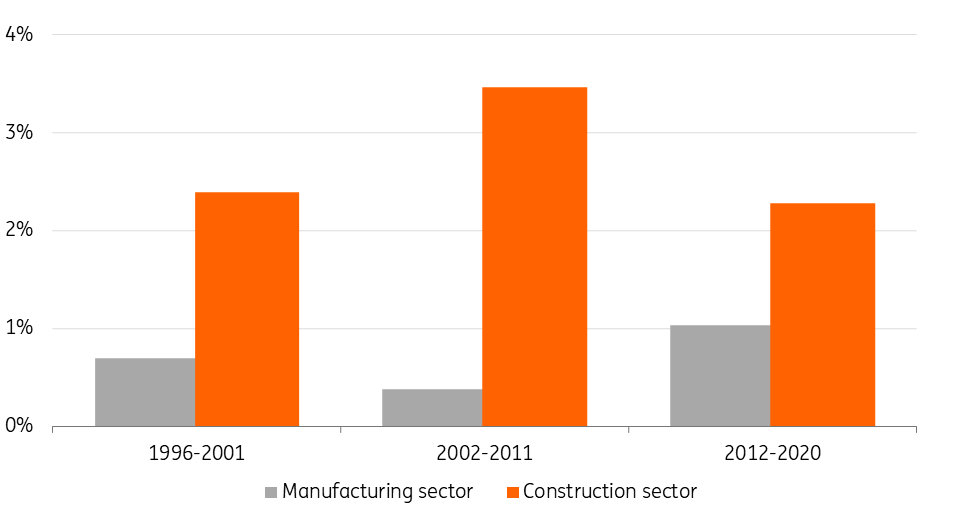
So why do construction firms raise – or have to raise – prices more often than their counterparts in manufacturing? We have to look at the cause of the productivity differences between these two sectors.
Decline in construction labour productivity
Construction labour productivity lags considerably behind manufacturing. It has almost doubled in manufacturing over the past 25 years, meaning that a manufacturing worker can now produce twice as much in the same number of hours. Growing efficiency means that the manufacturing industry is producing increasingly more in each working hour, often resulting in products becoming cheaper. Consider electronics, for example, which saw prices actually fall for a long time (until supply chain problems caused by the Covid-19 pandemic). By contrast, construction labour productivity increased by "only" 20% in the same period. Efficiency has thus increased much less in construction than in manufacturing. Because manufacturing firms have made far greater efficiency gains than building contractors, they were also able to pass on fewer price increases.
Construction labour productivity lags behind
Labour productivity of the added value in volume per hour worked in the EU, 1995-2021 (index 1995=100)
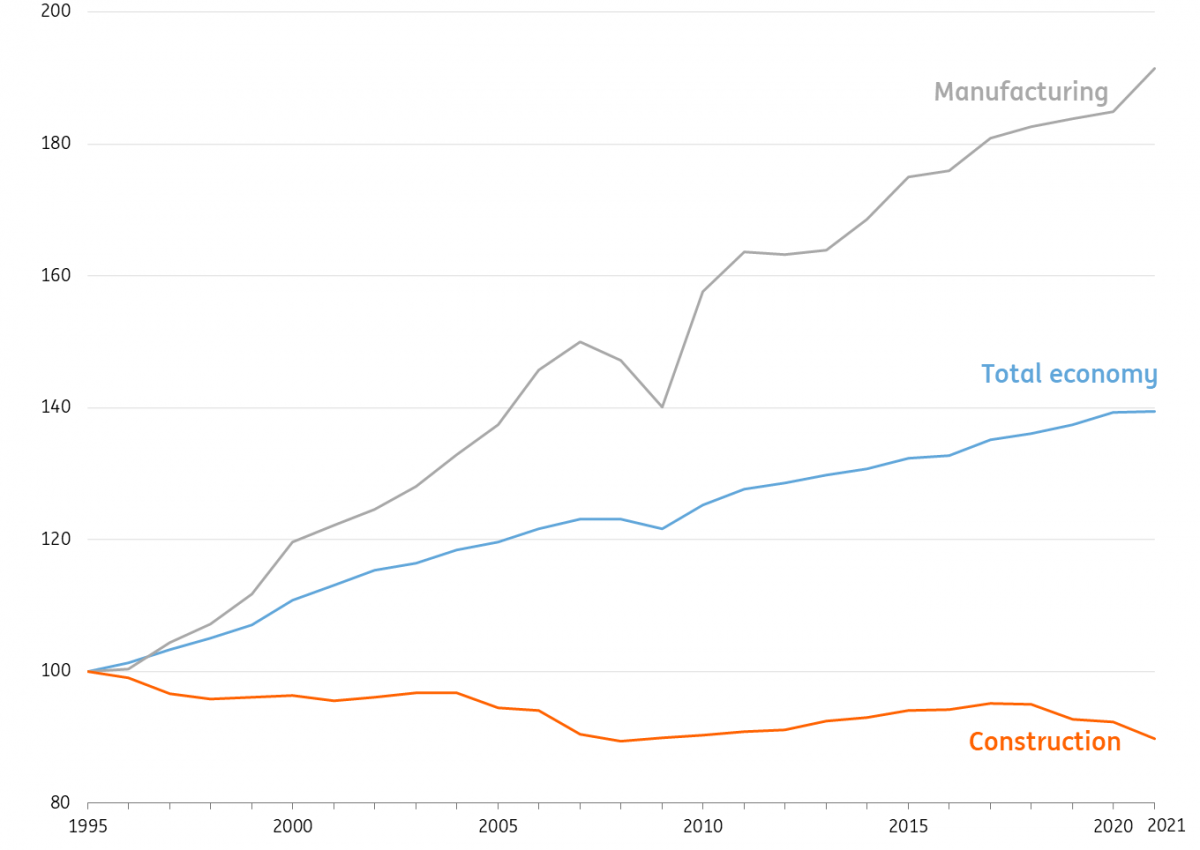
If labour productivity was 20% higher, 2.5 million fewer construction workers would be needed in the EU
Low labour productivity growth not only affects prices but also causes construction personnel shortages in many countries. By November 2022, more than 30% of EU building contractors could not complete all their work because of personnel shortages. This causes issues such as undermining the huge task of making real estate more sustainable. Nearly 14 million people work in construction in the EU. Additional productivity growth of 20%, for instance, could reduce the demand for additional construction workers in the EU by more than 2.5 million.
Productivity isn’t everything, but in the long run it is almost everything (Paul Krugman)
Productivity lags in Spain, France and Austria
Construction productivity trends vary widely across the EU. In France and Austria, labour productivity has fallen by more than 15% since 1995. In Spain, meanwhile, this figure has dropped by more than 25%. Declining construction output in these countries is the main reason for this trend. A drop in business turnover volume is usually not a fertile breeding ground for productivity. Contraction often creates overcapacity, meaning workers can be assigned less productively. Contraction and overcapacity also causes companies to invest less in new – and more efficient – machinery. In addition, the money is often not available for it and, because of the overcapacity, there is no need for it. Economies of scale also diminish with contraction.
Relatively high productivity growth in Belgian and Dutch construction
Labour productivity has not fallen in all countries. In fact, it has increased by around 20% in Belgium and the Netherlands. Construction output has increased in these countries, while investments in industrialisation and digitalisation are yielding positive results. Both countries also lead the way in digitalising the construction process.
Highest construction sector labour productivity growth in Belgium and the Netherlands
Construction labour productivity development, index 1995=100
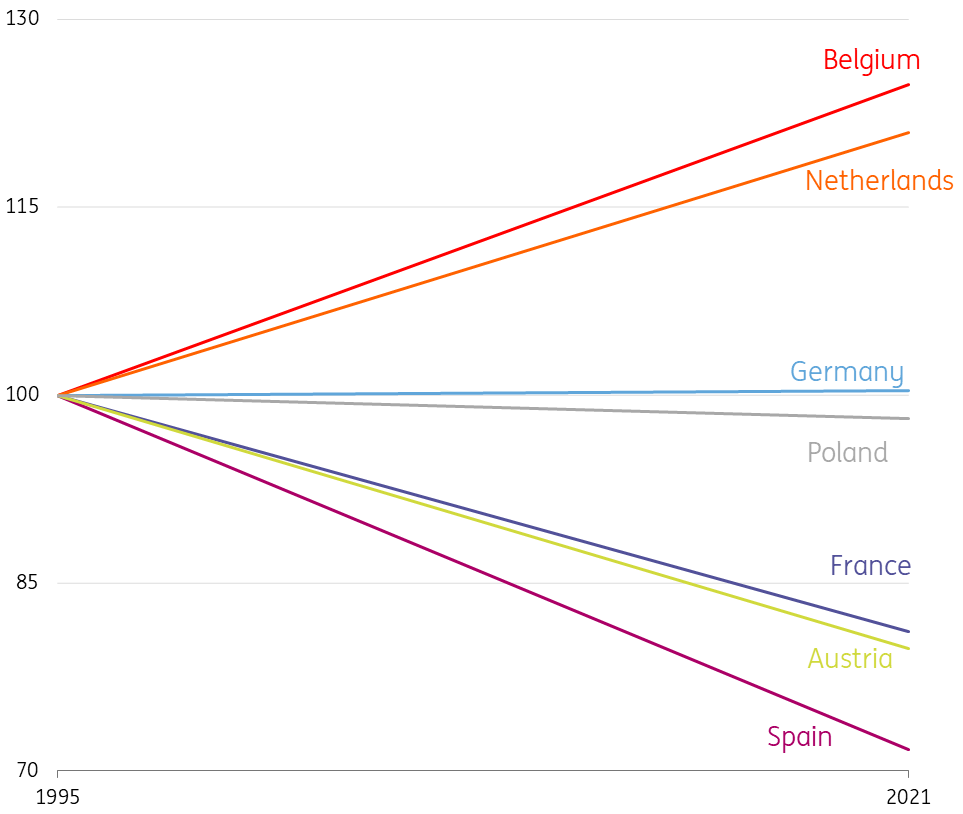
Capital productivity also falls behind in construction
Another less common way of looking at efficiency trends is through capital productivity instead of labour productivity. This shows the extent to which a sector uses capital efficiently: how much is produced per unit of capital (in value of machines, robots, business premises, ICT and so on).
Capital investment in construction did not yield a return for a long time
From 1995 to 2015, capital productivity in construction fell sharply in many countries. So, although construction firms invested in all kinds of capital assets, these could not be used efficiently. Investments in ICT, in particular, increased significantly in construction in many countries during that period. But construction firms have so far not managed to increase efficiency in this way. Since 2015, capital productivity in construction has risen slightly in the Netherlands and Austria, while it has remained relatively stable in Germany over the past 25 years. Despite a decline in German construction output, German construction firms also divested, keeping the output per unit of capital relatively stable.
Construction capital productivity falls in most countries
Construction sector capital productivity trends, index 2015=100
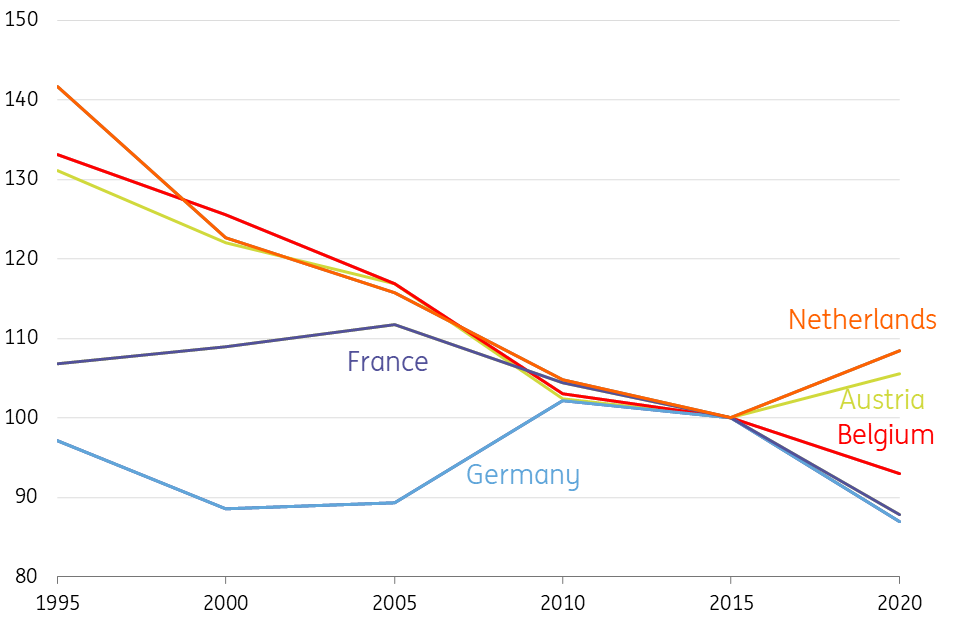
Need for flexibility makes innovation difficult
It is not that construction firms are wilfully opposed to innovation and increasing productivity. The culture of the sector is often cited as a cause: it is described as traditional and averse to new ideas. But the market structure of construction plays a more important role. This comes down to the following factors:
- Production is tied to specific locations: A construction firm works at a different location each time. Because production is tied to the location (construction site), the construction process is more difficult to industrialise (than in a factory building). Heavy machinery is difficult to move, conditions differ at every location and regulations vary from country to country. Flexibility is thus important, and construction firms retain this flexibility by doing a lot of work manually. This also means that few construction firms operate in other countries, so foreign construction innovations are also less readily implemented in other countries.
- Often building to someone else’s plan: The building design is often created by architects (although this practice is decreasing) and then outsourced with specifications and drawings. Construction firms, therefore, have to build something else each time and have to comply with regulations and requirements that often differ from one municipality to the next. Imagine this happening in the automotive industry, with every buyer having their dream car built based on their design drawings. Industrialisation would hardly be possible in those circumstances. This also promotes "beginner’s mistakes" (failure costs), does not encourage industrialisation of the construction process, and results in scant investment in machinery (which can often perform only one type of task).
- Volatile construction market: Because of the volatile demand for new construction, construction firms must remain flexible. Investments in production resources drive up fixed costs. In times of crisis, this can prove ruinous. Because construction is so localised, it is almost impossible to spread risks internationally, with a resurgence in one market counterbalancing a crisis in another. Lastly, construction companies cannot produce stock and cushion temporary shocks in demand by allowing stock to increase or decrease.
Need for flexibility makes innovation difficult
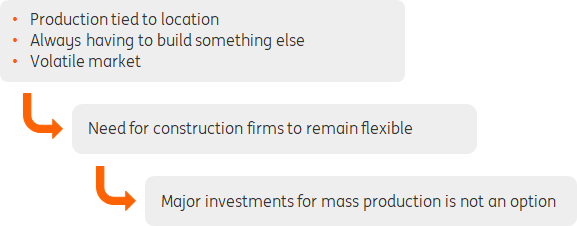
Productivity trends in construction subsectors
Within construction, labour productivity trends vary considerably between subsectors. Unfortunately, subsector data are not available for many EU countries. To gain some insight here, we use the case of the Netherlands where the data to calculate the productivity trend of the various subsectors are available.
High labour productivity growth in the residential and non-residential sector
The Dutch residential and non-residential sector has experienced much higher labour productivity growth over the past 25 years than other Dutch construction subsectors. Dutch builders such as Dijkstra Draisma, Daiwa House Modular Europe, Heijmans, Plegt-Vos and Van Wijnen are aiming to industrialise the construction process. This is paying off; labour productivity grew much faster in this Dutch subsector, by more than 40%, from 1995 to 2021. New residential and commercial building projects are also well-suited to industrialisation because this construction process can be standardised relatively well.
Average productivity growth in specialised construction
Productivity growth in Dutch specialised construction is almost the same as that in overall construction. Many of these construction processes are also difficult to industrialise. Customisation is often needed, especially for renovation and maintenance. However, digitalising can streamline business processes.
Productivity in the infrastructure sector has fallen
Labour productivity in the Dutch infrastructure sector has fallen in recent decades. First, this is because the sector contracted from 1995 to 2021. In 2021, 10% less was produced in this subsector than in 1995. As we mentioned above, contraction is usually not a fertile breeding ground for productivity growth. Second, infrastructure projects are also often more difficult to industrialise anyway because they involve a great deal of customisation, although, as in specialised construction, digitalising can certainly help.
Productivity gains among suppliers are also limited
It is often said that it is mainly suppliers that bring out product and process innovation, and thus efficiency in construction. This would then benefit the entire construction chain. However, if we look at the labour productivity of some key Dutch supply sectors, it is also relatively low.
Productivity growth higher in residential and non-residential construction
Labour productivity development in construction subsectors and various supply sectors (2021 vs 1995)

Digitalisation, industrialisation and timber construction can increase productivity
Despite the aforementioned obstacles, there are still ways for construction firms to increase their productivity, at least to some degree. This can be achieved through industrialisation, which mainly involves machines and/or robots. More efficient construction can also be achieved by using timber. Timber is not only much more sustainable but also a good industrial product to work with because it is much lighter. This means that large, prefabricated timber elements are easier to transport, can be processed with a greater degree of precision and are easier to attach. The lower weight also reduces the need for heavy machinery.
The other way to increase productivity is digitalising the construction process, with digital tools streamlining the construction process and making it more efficient. For example, providing information to all departments and chain partners can be greatly improved through digitalisation. Mistakes are also more likely to be avoided as a result. Managing separate information flows to colleagues and subcontractors can be automated with digitalisation so that all parties involved are constantly and automatically informed of the latest adjustments (SSOT: Single Source of Truth).
More efficient construction is essential for every firm
Efficiency gains are key to coping with personnel shortages, ensuring that your prices do not have to rise (too much) and keeping your business competitive. Further digitalisation is essential in this regard. Barriers to digitalisation, such as initial investments and risks, are relatively limited. While industrialisation must certainly also be considered, it is wise to proceed with caution because of the initial high investments (plant, machinery and robots). Construction firms that do not ensure they become more efficient will find themselves fishing in an increasingly small pond. They will also fail to make the move to a more sustainable and carbon-neutral business model.
This publication has been prepared by ING solely for information purposes irrespective of a particular user's means, financial situation or investment objectives. The information does not constitute investment recommendation, and nor is it investment, legal or tax advice or an offer or solicitation to purchase or sell any financial instrument. Read more
